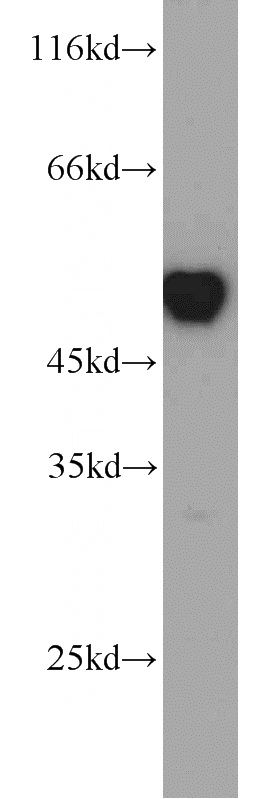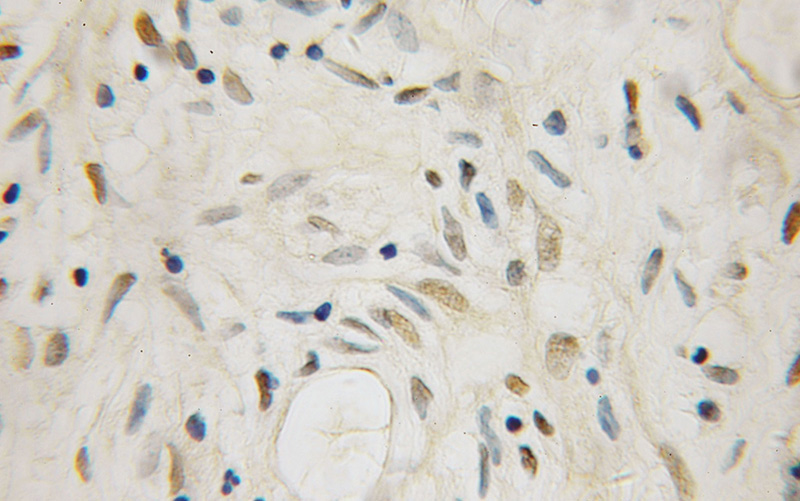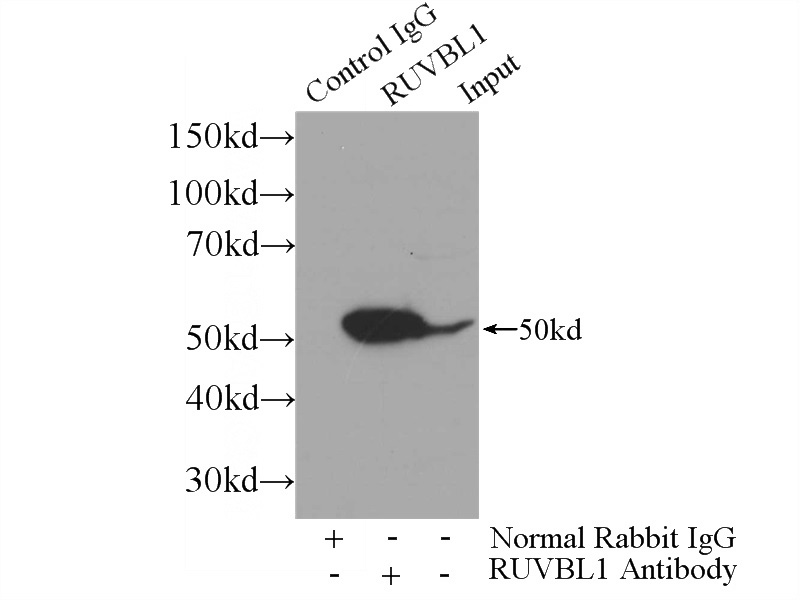-
Product Name
RUVBL1 antibody
- Documents
-
Description
RUVBL1 Rabbit Polyclonal antibody. Positive WB detected in HEK-293 cells, HeLa cells, HT-1080 cells, K-562 cells, mouse heart tissue, NIH/3T3 cells, rat testis tissue. Positive IP detected in HeLa cells. Positive IHC detected in human ovary tumor tissue. Observed molecular weight by Western-blot: 50kd
-
Tested applications
ELISA, WB, IHC, IP
-
Species reactivity
Human,Mouse,Rat; other species not tested.
-
Alternative names
49 kDa TBP interacting protein antibody; ECP 54 antibody; ECP54 antibody; INO80 complex subunit H antibody; INO80H antibody; Nuclear matrix protein 238 antibody; PONTIN antibody; Pontin 52 antibody; Pontin52 antibody; RuvB like 1 antibody; RuvB like 1 (E. coli) antibody; RUVBL1 antibody; RVB1 antibody; TAP54 alpha antibody; TIH1 antibody; TIP49 antibody; TIP49A antibody
-
Isotype
Rabbit IgG
-
Preparation
This antibody was obtained by immunization of RUVBL1 recombinant protein (Accession Number: NM_003707). Purification method: Antigen affinity purified.
-
Clonality
Polyclonal
-
Formulation
PBS with 0.1% sodium azide and 50% glycerol pH 7.3.
-
Storage instructions
Store at -20℃. DO NOT ALIQUOT
-
Applications
Recommended Dilution:
WB: 1:500-1:5000
IP: 1:500-1:5000
IHC: 1:20-1:200
-
Validations

HEK-293 cells were subjected to SDS PAGE followed by western blot with Catalog No:114939(RUVBL1 antibody) at dilution of 1:1000

Immunohistochemical of paraffin-embedded human ovary tumor using Catalog No:114939(RUVBL1 antibody) at dilution of 1:50 (under 10x lens)

IP Result of anti-RUVBL1 (IP:Catalog No:114939, 3ug; Detection:Catalog No:114939 1:1000) with HeLa cells lysate 800ug.
-
Background
RUVBL1 is a member of the AAA (ATPase associated with diverse cellular activities) family of proteins that is associated with several chromatin-remodelling complexes and has important roles in transcriptional regulation, the DNA damage response, telomerase activity, snoRNP assembly, cellular transformation and cancer metastasis[PMID: 21617703]. It consists of 456 amino acids (50 kDa) and interacts with TATA-binding protein (TBP), which is a central component for transcriptional regulation by forming complexes with various transcription regulators. RUVBL1 is a component of a large nuclear protein complex, possibly the RNA polymerase II holoenzyme. RUVBL1 is also highly homologous to RuvB proteins that function as a DNA helicase tpromote branch migration of the Holliday junction[PMID: 9588198]. This antibody is a rabbit polyclonal antibody to human RUVBL1.
-
References
- Taniue K, Oda T, Hayashi T, Okuno M, Akiyama T. A member of the ETS family, EHF, and the ATPase RUVBL1 inhibit p53-mediated apoptosis. EMBO reports. 12(7):682-9. 2011.
- Fielding AB, Dobreva I, McDonald PC, Foster LJ, Dedhar S. Integrin-linked kinase localizes to the centrosome and regulates mitotic spindle organization. The Journal of cell biology. 180(4):681-9. 2008.
- Dobreva I, Fielding A, Foster LJ, Dedhar S. Mapping the integrin-linked kinase interactome using SILAC. Journal of proteome research. 7(4):1740-9. 2008.
- Zhu H, Pei HP, Zeng S. Profiling protein markers associated with the sensitivity to concurrent chemoradiotherapy in human cervical carcinoma. Journal of proteome research. 8(8):3969-76. 2009.
- Oloumi A, Maidan M, Lock FE. Cooperative signaling between Wnt1 and integrin-linked kinase induces accelerated breast tumor development. Breast cancer research : BCR. 12(3):R38. 2010.
- Boulon S, Marmier-Gourrier N, Pradet-Balade B. The Hsp90 chaperone controls the biogenesis of L7Ae RNPs through conserved machinery. The Journal of cell biology. 180(3):579-95. 2008.
- Maeda Y, Suzuki T, Pan X. CUL2 is required for the activity of hypoxia-inducible factor and vasculogenesis. The Journal of biological chemistry. 283(23):16084-92. 2008.
- Franklin S, Chen H, Mitchell-Jordan S, Ren S, Wang Y, Vondriska TM. Quantitative analysis of the chromatin proteome in disease reveals remodeling principles and identifies high mobility group protein B2 as a regulator of hypertrophic growth. Molecular & cellular proteomics : MCP. 11(6):M111.014258. 2012.
Related Products / Services
Please note: All products are "FOR RESEARCH USE ONLY AND ARE NOT INTENDED FOR DIAGNOSTIC OR THERAPEUTIC USE"
